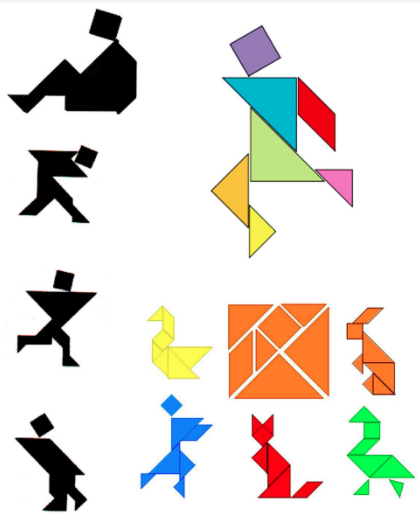
Learning About and Making Tangrams

Overview
Students will be able to learn about tangrams and basic shapes through a read-aloud of Grandfather Tang’s Story, which describes various animals being made with Tangrams, understand how they make shapes by reading the book Tricky Tangrams, and then try making tangrams themselves using a game on digipuzzle.net.
Learning Objectives
Students will:
- Understand the cultural history of tangrams.
- Understand the basic shapes that compose a set of tangrams.
- Be able to create pictures using tangram shapes.
Vocabulary
Vocabulary Words:
- Tangram: A tangram is a very old puzzle that came from China. It has seven pieces, called “tans” that can be put together to make shape pictures, and they fit together in a square. They can be made out of wood or paper.
- Triangle: A triangle is a closed plane figure having three sides and three angles.
- Square: A square is a rectangle having all four sides of equal length.
Pre-planning
To prepare for this lesson:
-
Watch the YouTube video Grandfather Tang’s Story and read the book Tricky Tangrams to familiarize yourself with the cultural relevance of tangrams and how they create pictures.
-
Learn how to use tangrams in the classroom by watching this video Teaching With Tangrams.
-
Know the three rules for creating tangram shapes to explain to students:
-
Three rules to using tangrams:
-
You must use all seven pieces
-
Every tan must touch another tan.
-
The tans can’t go over the top of other tans.
-
Use your own set of tangrams to create the shapes as the story is being read aloud.
-
-
Accommodations
See Accommodations Page and Charts on the 21things4students.net site in the Teacher Resources.
Steps
Directions for this activity:
This is can be a classroom activity if following the directions below; adapted as a virtual activity with links provided.
- Introduction: Have students read the book Tricky Tangrams online at Epic.
- Explain what a tangram is by providing vocabulary words and expectations.
- Read the book: Read Grandfather Tang’s Story to students to give them cultural relevance and the opportunity to see tangrams making shapes and pictures.
Activity: Allow them to try making shapes on their own with tangrams (in person) or online at Digipuzzle.
Assessment Options
Different options for assessing the students:
- Observations
- Check for understanding
- Share tangram puzzle completions using digipuzzle.net and share using one of the options listed on the website:

Facebook, Twitter, Pinterest, Google Classroom, or QR code.
- May also have students create their own tangram pictures: a number, their first initial, etc. and take a picture to post or share.
MITECS Competencies & ISTE Standards
MITECS: Michigan adopted the "ISTE Standards for Students" called MITECS (Michigan Integrated Technology Competencies for Students) in 2018.
Knowledge Constructor
3c. Curate information from digital resources using a variety of tools and methods to create collections of artifacts that demonstrate meaningful connections or conclusions.
Innovative Designer
4a. Know and use a deliberate design process for generating ideas, testing theories, creating innovative artifacts, or solving authentic problems.
Devices and Resources
Device: PC, Chromebook, Mac, iPad
Browser: Chrome, Safari, Firefox, Edge, ALL
App, Extension, or Add-on:
The activity will require setting up an account on www.getepic.com if needed for the Tricky Tangram book.
Websites:
Digipuzzle
Grandfather Tang’s Story Read-Aloud
CONTENT AREA RESOURCES
ELA
- Students read/listen to books, Grandfather Tang’s Story and Tricky Tangrams and compare fiction/non-fiction writing.
- Read another story about China or grandparents - find one that is fiction and one that is non-fiction.
- Show students where fiction and non-fiction books are in a library and how they are organized differently (author’s last name and Dewey Decimal System).
- After reading a story about China or grandparents, have students write a short research paper about either.
- Have students interview their grandparents and share video and written transcripts.
Integrated Arts
- Have students create a video sharing how they created their shape picture, step-by-step, and “publish” for the classroom.
- Encourage students to talk to their grandparents about their heritage/culture and make a video.
- Have students collect photos of grandparents and create a collage or video with the collection.
Math
- Students learn basic shapes like triangles and squares.
- Students can learn more about parallelograms and rhomboid shapes.
- Students use spatial reasoning to create pictures with basic shapes.
- Students learn the basic rules of tangrams and apply them to a new design they create.
- Students can measure their tangram shapes and apply that knowledge to the area of the tangram square.
Science
- Students can investigate shapes around them: square, triangle, parallelogram in nature, and in the classroom or home.
- Take a field trip to find shapes and repeating patterns (pieces that make a whole) in nature.
Social Studies
Have students interview their grandparents and share video and written transcript.
CREDITS
This task card was created by Caryn Parker, Gull Lake Virtual Partnership, December 2020. Updated September 2023.


